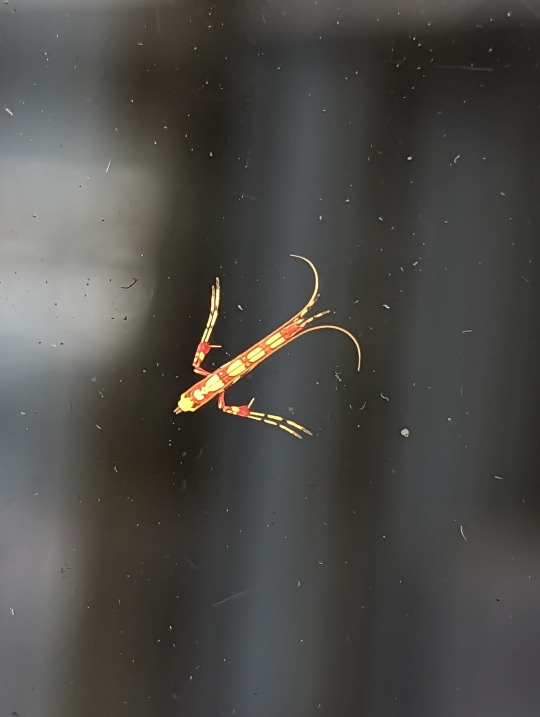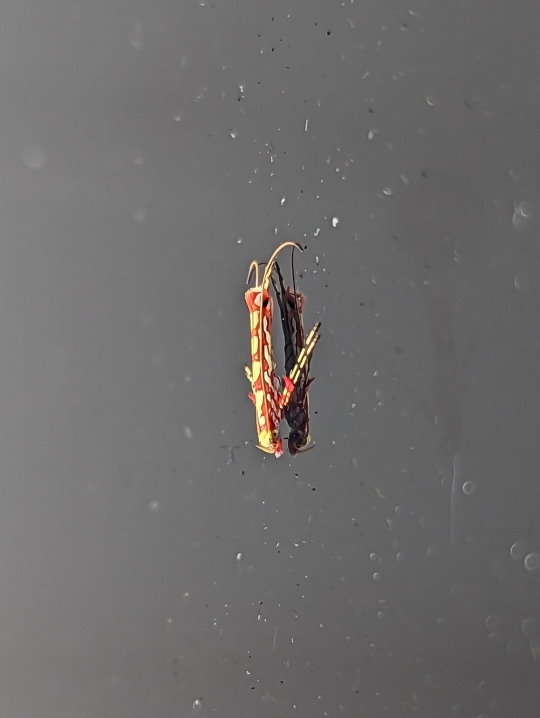#leaf blotch miner moth
Explore tagged Tumblr posts
Photo



Leaf blotch miner moth, Caloptilia protiella, Gracillariidae
Photographed at Airlie Beach, Australia by Steve & Alison1
Shared with permission; do not remove credit or re-post!
#animals#curators on tumblr#insects#bugs#moth#leaf blotch miner moth#Caloptilia protiella#one nice bug#stupid lookin dude no offense
6K notes
·
View notes
Text
Original miner moth image from
0 notes
Text


Beautiful Macarostola moth found on the glass window of a Kmart.
24/11/23 - Macarostola sp.
QLD:WET
#invertblr#invertebrates#bugs#bugblr#bugs tw#bug#insects#insecta#insects tw#insectblr#insect#entomology#Arthropods#Arthropoda#Macarostola#Gracillariidae#Leaf Blotch Miner Moths#Lepidoptera#lepidopterology#moths#mothblr#moth#mothcore#moths tw#unidentified
824 notes
·
View notes
Text



What I believe is the trail of a Leaf Blotch Miner Moth Larvae (Family Gracillariidae...) on a Sweet Gum Tree leaf (Liquidambar styraciflua)
#nature#my photography#nature photography#moth caterpillar#wildlife photography#moth#moth larva#backyard nature#insect
6 notes
·
View notes
Text
my favourite moth is probably the coffee clearwing, or this leaf blotch miner moth


I forgot th credits
what is your favorite moth (or butterfly) species? :D
mine are
the Polyphemus moth and Chickweed Geometer!
both of which are native to my state ^^


54 notes
·
View notes
Photo


Inktober seems fun so here’s some (very) last minute noodly doodlies of a ranger girl with her miner moth companion and a candy corn witch before I go to bed!
#oc#ocs#original character#inktober#pathfinder oc#halloween witch#witch#candy corn witch#leaf blotch miner moth#ink doodles
18 notes
·
View notes
Photo

Bug of the Day
A wee leaf blotch miner moth (Acrocercops astericola) at the light at Sibley Farm a few weeks ago. I’m really glad it finally decided to stay still long enough for me to photograph it; it was hopping all over the sheet!
#Acrocercops astericola#Acrocercops#leaf blotch miner#leaf blotch miner moth#Gracillariidae#Lepidoptera#moth#insect
119 notes
·
View notes
Text
Half of Europe’s endemic trees at risk
More than half of Europe’s endemic tree species – those native to Europe only – are at risk of extinction, and 15% are critically endangered, according to a new report from the International Union for Conservation of Nature (IUCN). Ash, elm, rowans and horse chestnuts are among the 454 species on the IUCN’s Red List, owing to a combination of invasive plants, pests and diseases, logging and urbanisation. Some are facing multiple threats: horse chestnuts, which are classed as “vulnerable”, are being attacked by the leaf-miner moth and the horse chestnut scale insect, as well as a fungal disease called leaf blotch and bleeding canker bacteria. Bleeding canker, which can kill a tree outright, is believed to be present in more than 50% of horse chestnuts in Britain.
David Allen, one of the report’s authors, said the threat to native trees could complicate efforts to tackle climate change: governments planning to import young trees to create new forests will need to make sure the saplings are properly screened. “We have to be very careful to ensure they don’t come with pest species,” he said.
The Week, issue 1248, October 2019
0 notes
Photo








Red and yellow leaf miner moth, Macarostola miniella, Gracillariidae
Found on the North Island of New Zealand
Photos 1-7 by invertebratist and 8 (for scale) by stephen_thorpe
#animals#curators on tumblr#insects#bugs#moth#leaf miner moth#leaf miner#red and yellow leaf miner moth#Macarostola miniella#Gracillariidae#one nice bug#leaf blotch miner moth
705 notes
·
View notes
Photo


Caloptilia belfragella
...is a species of leaf blotch miner moth (Gracillariidae) that is native to Central North America. C. belfragella larvae feed mainly on Cornus spp., Rhun typhina, and Vaccinium spp. True to their family name the larvae will "mine" through the leaves of their host plants creating noticeable damage.
Classification
Animalia-Arthropoda-Insecta-Lepidoptera-Gracillarioidea-Gracillariidae-Gracillariinae-Caloptera-belfragella
Image(s): ©John Lee
#Gracillariidae#Moths#Lepidoptera#Insecta#Leaf Blotch Miner Moth#Gracillarioidea#Gracillariinae#Caloptera#North America#Caloptilia belfragella
191 notes
·
View notes
Photo

Bug of the Day
I did not expect to be able to id this teeny micro moth to species, but I lucked out with the distinct patterning - this is a leaf blotch miner, Neurobathra strigifinitella.
170 notes
·
View notes
Photo
Funky little dude



Leaf blotch miner moth, Caloptilia protiella, Gracillariidae
Photographed at Airlie Beach, Australia by Steve & Alison1
Shared with permission; do not remove credit or re-post!
6K notes
·
View notes